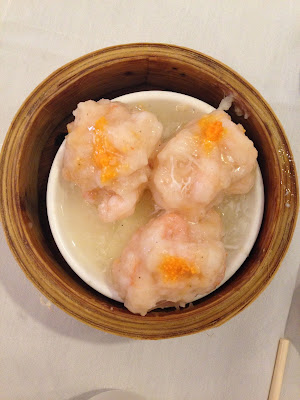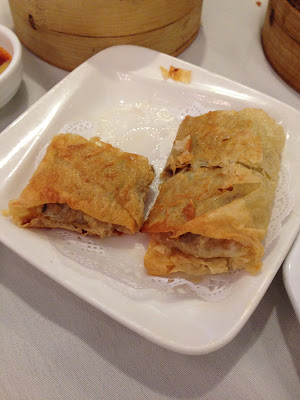Dim Sum at Asian Jewels Seafood Restaurant
Whenever I come back to New York, the first thing I ask for when I arrive and the last thing I ask for when I leave are always dim sum. Although Philadelphia has a handful of dim sum restaurants of its own, none of them can even rival the quality, creativity, and environment of their New York counterparts. Quality can always be assessed by the freshness of the ingredients - how tender the shrimps in the har gow, or how fatty the pork in the char siu bao. On top of executing these classics, a good dim sum destination should also have a few dishes that can't be found anywhere else. This can include dessert buns that have more of a western influence or an innovative seafood-vegetable combination. Unlike American brunch spots, which aim for a quiet, relaxed atmosphere, Cantonese restaurants on weekend mornings are bustling with the sound of steam cart ladies shouting, little kids screaming, and dishes clattering as dirty tables are hurriedly changed for the next party. True, the environment is chaotic and the steam cart ladies are always trying to sell you more dishes than you can eat, but that's the beauty of the experience, at least for me. With all this in mind, my family and I decided to go to Asian Jewels Seafood Restaurant in Flushing before I headed back to Philly.
Tea:
Dim sum always starts with tea. In fact, going out for dim sum is actually called "yum cha" in Cantonese, translating into "to drink tea". Originally light snacks served alongside tea for weary travelers at teahouses, over the last thousand years or so (the precise dates are debatable), dim sum has transformed into tapa-sized dishes and "yum cha" has put greater emphasis on the food than on the tea. However, tea is still necessary and most restaurants will offer a choice of chrysanthemum, green, and possibly oolong or pu-erh.
Shrimp Dumpling:
Once we ordered a pot of chrysanthemum tea, the steam cart ladies began their coordinated attack: a calculated dance of carts moving back and forth, one immediately following the other, at a pace so fast that we couldn't stop to question whether we were ordering too much. Our first pick was a shrimp dumpling I did not know the name of. It had the shape of siu mai but lacked the thin sheet of dough. Perched on top of pieces of wintermelon and topped with shrimp roe, the shrimp was tender and the taste was clean.
Jiu Cai Bao:
Next came the jiu cai bao- pan fried wheat starch skin dumplings filled with chives and dry shrimp. A dim sum staple, the chive dumpling has a slight crisp and a chewy skin that encases a generous, savory filling.
Cheong Fan:
Cheong fan, or rolled rice noodles, are broad, steamed rice noodles filled with either beef or shrimp and then drizzled with sugary soy sauce. If you want real chunks of meat, order the shrimp cheong fan. For some, the beef cheong fan (like the one pictured) can be unfamiliar at first because the filling is heavily mixed with rice flour.
Durian Puff:
The durian puff consists of a soft center of mashed durian pulp wrapped in layers of flaky, puff pastry-esque dough. For durian first-timers, the smell can be quite pungent and the taste can be too rich, but the sweet, gooey center is the perfect match with the crumbly pastry shell.
Har Gow:
The king of all dishes, har gow is the one item every dim sum experience must have and also the best measurement of the chef's skill. Stretchy wheat starch skin holds a center consisting of whole piece of shrimp and bamboo shoots.
Steamed Pei Guen:
This dish involves tofu skin being wrapped around either shrimp, meat, or vegetables. For our particular version, there was mushroom, bamboo, carrot, celery, and various other vegetables. I enjoyed how it was light and not too greasy.
Fried Pei Guen:
Basically the same concept as steamed pei guen, except fried, this dish wasn't as good as its steamed counterpart. It felt like it could have used a bit more filling, but that could be due to the fact that the roll got flattened when pan-fried.
Turnip Cake:
Although it's called turnip cake, it's actually made with white daikon radishes. Starchy and soft, turnip cakes are made from a mixture of flour and shredded radishes, while shrimp, ham, or vegetables are used for seasoning.
Egg Custard Bun:
Probably my favorite dessert, the egg custard bun has a golden yellow center that is made from custard powder, wheat starch, sugar, milk, butter, and egg. Buttery and sweet, yet slightly salty at the same time, the center should be molten. The version Asian Jewels made was so perfectly delicate that the custard spilled over the fluffy, white bun.
Preserved Egg and Pork Congee:
Preserved egg can be unappetizing in appearance: the egg whites have transformed into a translucent black and the yolks are eerily green. The taste is also funky and I personally don't like eating it by itself. However, paired with pork, an unexpected umami is formed.
White Sesame Bun:
I've never tried this anywhere else, but it seemed like a mini sesame steamed bun that was then fried to give a golden exterior. The filling was slightly too sugary and lacked a strong sesame taste, but the idea was novel.
Watercress Dumpling:
These were small, wheat starch skin dumplings with centers of watercress and dried shrimp. They were quite tasty but similar to the chive dumplings, so I would recommend only getting one of the two.
The dishes we ordered at Asian Jewels were only a fraction of the items that can be found across dim sum restaurants. Overall, I was very satisfied with both the quality and the size of the selection, and I would definitely go back again for their weekday deals.
Tea:
Dim sum always starts with tea. In fact, going out for dim sum is actually called "yum cha" in Cantonese, translating into "to drink tea". Originally light snacks served alongside tea for weary travelers at teahouses, over the last thousand years or so (the precise dates are debatable), dim sum has transformed into tapa-sized dishes and "yum cha" has put greater emphasis on the food than on the tea. However, tea is still necessary and most restaurants will offer a choice of chrysanthemum, green, and possibly oolong or pu-erh.
Shrimp Dumpling:
Once we ordered a pot of chrysanthemum tea, the steam cart ladies began their coordinated attack: a calculated dance of carts moving back and forth, one immediately following the other, at a pace so fast that we couldn't stop to question whether we were ordering too much. Our first pick was a shrimp dumpling I did not know the name of. It had the shape of siu mai but lacked the thin sheet of dough. Perched on top of pieces of wintermelon and topped with shrimp roe, the shrimp was tender and the taste was clean.
Next came the jiu cai bao- pan fried wheat starch skin dumplings filled with chives and dry shrimp. A dim sum staple, the chive dumpling has a slight crisp and a chewy skin that encases a generous, savory filling.
Cheong fan, or rolled rice noodles, are broad, steamed rice noodles filled with either beef or shrimp and then drizzled with sugary soy sauce. If you want real chunks of meat, order the shrimp cheong fan. For some, the beef cheong fan (like the one pictured) can be unfamiliar at first because the filling is heavily mixed with rice flour.
The durian puff consists of a soft center of mashed durian pulp wrapped in layers of flaky, puff pastry-esque dough. For durian first-timers, the smell can be quite pungent and the taste can be too rich, but the sweet, gooey center is the perfect match with the crumbly pastry shell.
The king of all dishes, har gow is the one item every dim sum experience must have and also the best measurement of the chef's skill. Stretchy wheat starch skin holds a center consisting of whole piece of shrimp and bamboo shoots.
This dish involves tofu skin being wrapped around either shrimp, meat, or vegetables. For our particular version, there was mushroom, bamboo, carrot, celery, and various other vegetables. I enjoyed how it was light and not too greasy.
Basically the same concept as steamed pei guen, except fried, this dish wasn't as good as its steamed counterpart. It felt like it could have used a bit more filling, but that could be due to the fact that the roll got flattened when pan-fried.
Although it's called turnip cake, it's actually made with white daikon radishes. Starchy and soft, turnip cakes are made from a mixture of flour and shredded radishes, while shrimp, ham, or vegetables are used for seasoning.
Egg Custard Bun:
Probably my favorite dessert, the egg custard bun has a golden yellow center that is made from custard powder, wheat starch, sugar, milk, butter, and egg. Buttery and sweet, yet slightly salty at the same time, the center should be molten. The version Asian Jewels made was so perfectly delicate that the custard spilled over the fluffy, white bun.
Preserved Egg and Pork Congee:
Preserved egg can be unappetizing in appearance: the egg whites have transformed into a translucent black and the yolks are eerily green. The taste is also funky and I personally don't like eating it by itself. However, paired with pork, an unexpected umami is formed.
I've never tried this anywhere else, but it seemed like a mini sesame steamed bun that was then fried to give a golden exterior. The filling was slightly too sugary and lacked a strong sesame taste, but the idea was novel.
Watercress Dumpling:
These were small, wheat starch skin dumplings with centers of watercress and dried shrimp. They were quite tasty but similar to the chive dumplings, so I would recommend only getting one of the two.
The dishes we ordered at Asian Jewels were only a fraction of the items that can be found across dim sum restaurants. Overall, I was very satisfied with both the quality and the size of the selection, and I would definitely go back again for their weekday deals.

















Comments
Post a Comment